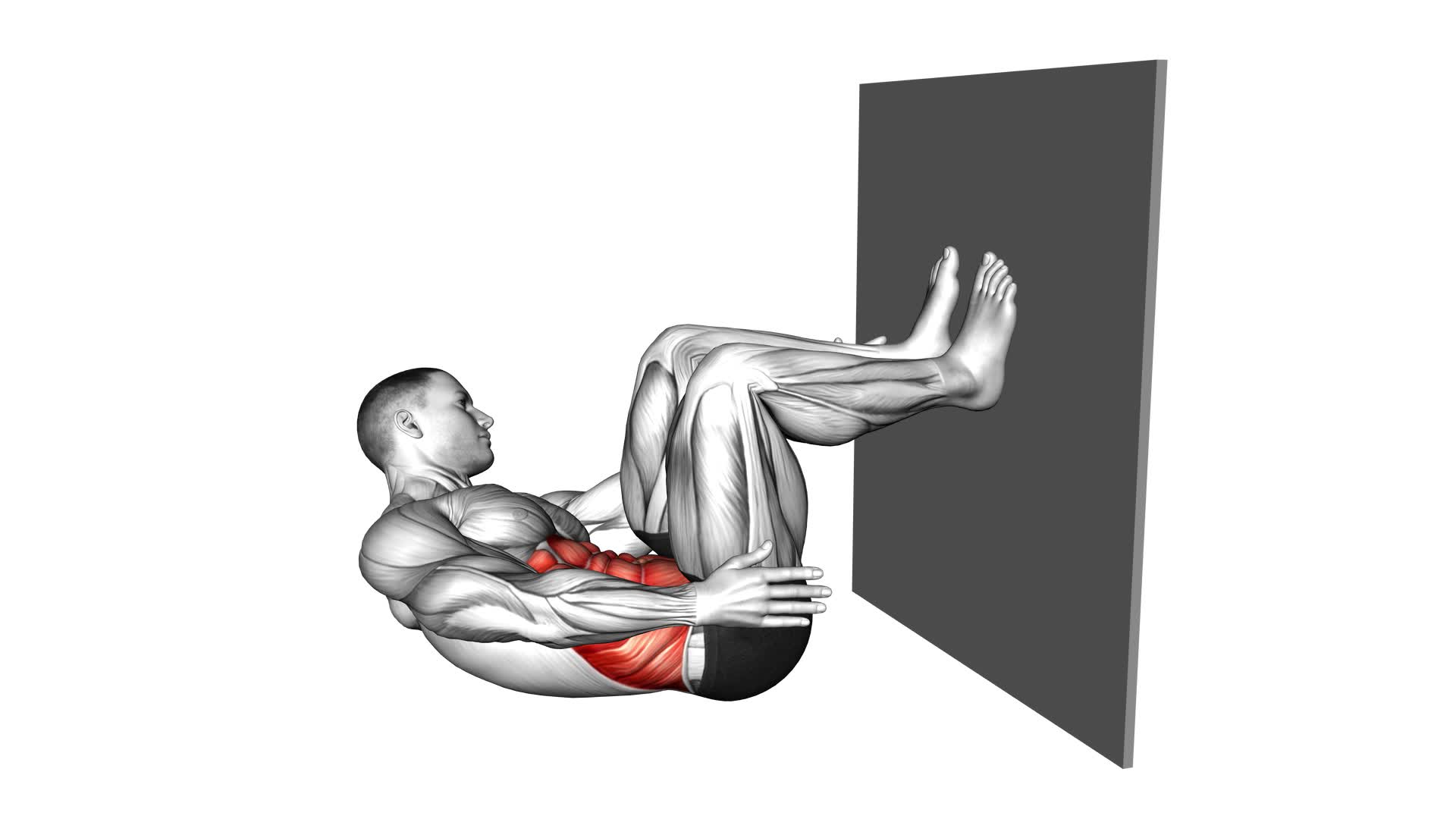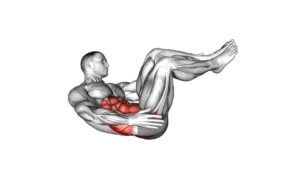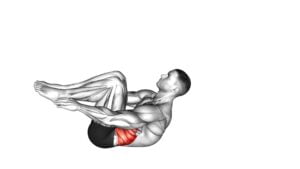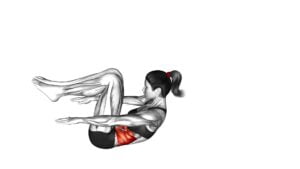90 Degree Heel Touch Against Wall (Male) – Video Exercise Guide & Tips

Are you looking to strengthen your core and improve your flexibility?
Watch This Exercise Video
Check out this video exercise guide for the 90 Degree Heel Touch Against Wall. In this quick and effective workout, you'll learn the proper form and technique to target your abs and obliques.
Watch the video and follow along to see results in no time.
Don't miss out on this great exercise for your routine!
Key Takeaways
- The 90 Degree Heel Touch against the wall targets the abdominal muscles, specifically the obliques, and improves core strength and stability.
- Proper form and safety are important, including maintaining parallel and forward-pointing foot position, distributing weight evenly between both feet, and avoiding leaning forward or lifting heels off the ground.
- There are additional benefits and variations to explore, such as targeting other muscle groups like the glutes, hamstrings, and quadriceps, experimenting with different foot positions, and increasing intensity with ankle weights or resistance bands.
- Modifications and progressions can be made to suit individual needs and goals, such as adjusting the angle, using a chair or bench for support, adding resistance, or challenging oneself by performing the exercise on one leg.
Benefits of 90 Degree Heel Touch Against Wall
To maximize the effectiveness of your workout, incorporating the 90 degree heel touch against the wall can provide numerous benefits. This exercise targets your abdominal muscles, specifically the obliques, and helps to improve core strength and stability. By placing your feet against the wall at a 90 degree angle, you create a stable base and engage your lower abs more effectively.
There are several variations of the 90 degree heel touch that you can incorporate into your routine. One option is to perform the exercise with your legs straight up against the wall, keeping your knees locked. This variation increases the intensity of the exercise and engages your lower abs even more.
Proper foot placement techniques are crucial for maximizing the effectiveness of the 90 degree heel touch against the wall. Make sure your feet are hip-width apart and pressed firmly against the wall. This will provide stability and prevent your feet from slipping during the exercise.
Incorporating the 90 degree heel touch against the wall into your workout routine can help you achieve a stronger core and improve your overall fitness level. Remember to start with proper foot placement and consider trying different variations to challenge yourself and continue making progress.
Proper Form and Technique for 90 Degree Heel Touch Against Wall
When performing the 90 Degree Heel Touch Against Wall exercise, it's important to pay attention to your foot placement. Placing your feet too far from the wall can make the exercise less effective, so make sure they're positioned correctly.
Additionally, be mindful of common mistakes such as leaning forward or lifting your heels off the ground, as these can compromise the proper form and technique.
Foot Placement Tips
Ensure proper foot placement for the 90-degree heel touch against the wall by positioning your feet shoulder-width apart. This is a crucial aspect of executing the exercise with proper form and technique.
When placing your feet, make sure they're parallel to each other and pointing forward. This will help maintain stability and balance throughout the movement.
Additionally, distribute your weight evenly between both feet to avoid leaning or favoring one side. By following these foot placement techniques, you'll be able to engage the correct muscles and maximize the effectiveness of the exercise.
Common Mistakes to Avoid
Avoiding common mistakes is essential for maintaining proper form and technique while performing the 90-degree heel touch against the wall exercise. In addition to focusing on foot placement, there are a few other important aspects to consider.
Firstly, proper breathing technique during the exercise is crucial. It's recommended to exhale as you reach your heel towards the wall and inhale as you return to the starting position. This helps engage your core and stabilizes your body throughout the movement.
Secondly, warming up before attempting the exercise is of utmost importance. This helps prepare your muscles, joints, and connective tissues for the intensity of the exercise, reducing the risk of injury. A dynamic warm-up routine that includes stretching and mobility exercises specific to the lower body can greatly enhance your performance and prevent any potential harm.
Remember to always prioritize safety and listen to your body's limitations.
Benefits and Variations
To maximize the benefits and explore different variations of the 90-degree heel touch against the wall exercise, it's important to maintain proper form and technique. Here are some key benefits and variations to consider:
Benefits:
- Improves balance and stability by challenging your lower body muscles.
- Targets the glutes, hamstrings, and quadriceps for muscle activation and strength development.
Variations:
- Experiment with different foot positioning to target specific muscle groups. Placing your feet closer together targets the inner thigh muscles, while a wider stance targets the outer thigh muscles.
- Increase the difficulty by adding resistance. You can do this by using ankle weights or resistance bands around your ankles.
By understanding the benefits and trying out different variations, you can customize the exercise to suit your goals and target specific muscle groups.
Now, let's explore the modifications and progressions for the 90-degree heel touch against the wall exercise.
Modifications and Progressions for 90 Degree Heel Touch Against Wall
Now let's explore some advanced progression options to challenge yourself further in the 90 Degree Heel Touch Against Wall exercise.
Additionally, it's important to be aware of common modification mistakes that may hinder your progress.
Lastly, keep safety considerations in mind when making modifications to ensure you're performing the exercise safely and effectively.
Advanced Progression Options
You can challenge yourself further with the advanced progression options for the 90 Degree Heel Touch Against Wall exercise by incorporating modifications and progressions.
Here are some effective variations to take your workout to the next level:
- Increase the range of motion: Instead of touching your heels to the wall at a 90-degree angle, aim to touch them higher up on the wall. This will engage your core and hip flexors even more.
- Add resistance: Hold a dumbbell or kettlebell in each hand while performing the exercise. This will increase the difficulty and help build strength in your upper body.
- Integrate balance challenges: Try performing the exercise on an unstable surface, such as a balance board or Bosu ball. This will require your muscles to work harder to maintain stability.
- Incorporate plyometrics: Instead of simply touching the wall, explode off the ground and reach for the wall with both heels. This will add a cardiovascular component to the exercise and improve power and explosiveness.
Common Modification Mistakes
Avoid these common modification mistakes when performing the 90 Degree Heel Touch Against Wall exercise to ensure proper form and maximize your workout.
One common mistake is incorrect foot positioning. Make sure your feet are hip-width apart and parallel to each other. This will provide a stable base and prevent any unnecessary strain on your joints.
Another mistake to avoid is improper alignment. Keep your body straight and aligned from head to toe, with your shoulders, hips, and heels touching the wall. This will help engage the correct muscles and prevent any potential injuries.
By avoiding these modification mistakes, you can ensure that you're performing the exercise correctly and getting the most out of your workout.
Now let's move on to the next section about safety considerations for modifications.
Safety Considerations for Modifications
To ensure your safety while modifying the 90 Degree Heel Touch Against Wall exercise, consider implementing appropriate modifications and progressions. By following these modifications, you can minimize the risk of injury and maximize the effectiveness of the exercise:
- Use a stability ball: Instead of performing the exercise against a wall, you can use a stability ball to provide support and stability to your lower back.
- Decrease the range of motion: If you find it challenging to touch your heels to the wall, start by aiming for a smaller range of motion and gradually increase it as you build strength and flexibility.
These modifications prioritize safety and injury prevention while allowing you to still benefit from the exercise. By implementing these modifications, you can safely work towards improving your flexibility and strength.
Now, let's move on to the next section to learn about common mistakes to avoid during the 90 Degree Heel Touch Against Wall exercise.
Common Mistakes to Avoid During 90 Degree Heel Touch Against Wall
One common mistake during the 90 Degree Heel Touch Against Wall exercise is improper alignment of the hips. To perform this exercise correctly, it's important to maintain proper foot positioning and hand placement.
When positioning your feet, make sure they're shoulder-width apart and parallel to each other. This will provide a stable base of support and prevent any unnecessary strain on the ankles and knees. Additionally, ensure that your hands are placed firmly against the wall at shoulder height. This will help you maintain balance and stability throughout the exercise.
Another mistake to avoid is rounding or arching your back. Keep your spine in a neutral position by engaging your core muscles. This will help you maintain proper alignment and prevent any undue stress on your lower back.
Lastly, be mindful of your range of motion. Avoid forcing your legs to touch the wall if you feel discomfort or pain. Gradually increase your range of motion over time as your flexibility improves. Remember, it's better to perform the exercise with proper form and alignment rather than sacrificing it for a greater range of motion.
Tips for Incorporating 90 Degree Heel Touch Against Wall Into Your Workout Routine
To incorporate the 90 Degree Heel Touch Against Wall into your workout routine, start by including it as a warm-up exercise before your main workout. This will help activate your leg muscles and improve flexibility, preparing you for more intense exercises. Here are some tips to help you incorporate this exercise effectively:
- Incorporating Modifications:
- If you're a beginner, you can start by performing the heel touch against a wall without the 90-degree angle. Gradually increase the angle as you build strength and flexibility.
- For those with limited mobility or knee issues, you can modify the exercise by using a chair or bench for support. This will reduce the strain on your knees while still engaging your leg muscles.
- Advanced Progressions:
- Once you have mastered the basic 90 Degree Heel Touch Against Wall, you can challenge yourself by adding ankle weights or holding dumbbells to increase resistance.
- To further intensify the exercise, try performing it on one leg at a time. This will require more balance and stability, engaging your core muscles as well.
Incorporating these modifications and advanced progressions will help you continually progress and avoid plateauing in your fitness journey. Remember to listen to your body, and if you experience any pain or discomfort, consult with a fitness professional.
In the next section, we'll discuss safety precautions and considerations for the 90 Degree Heel Touch Against Wall exercise.
Safety Precautions and Considerations for 90 Degree Heel Touch Against Wall
As you incorporate the 90 Degree Heel Touch Against Wall into your workout routine, it's important to consider the safety precautions and guidelines to prevent any potential injuries. By following these safety precautions and maintaining proper form, you can ensure a safe and effective workout.
Firstly, it's crucial to warm up your body before performing any exercise. This helps to increase blood flow, improve flexibility, and reduce the risk of injury. Incorporate dynamic stretches and light cardio exercises into your warm-up routine.
When performing the 90 Degree Heel Touch Against Wall, make sure to maintain proper form throughout the exercise. Stand with your back against the wall, keeping your feet shoulder-width apart. Keep your core engaged and your back pressed firmly against the wall. As you lift your legs, ensure that your knees stay at a 90-degree angle.
Additionally, listen to your body and avoid pushing yourself too hard. Start with a comfortable range of motion and gradually increase it over time. If you experience any pain or discomfort, stop the exercise immediately.
Lastly, always consult with a healthcare professional or a certified trainer before starting any new exercise program. They can provide personalized advice and guidance based on your individual needs and abilities.
Frequently Asked Questions
How Many Sets and Reps Should I Do for the 90 Degree Heel Touch Against Wall Exercise?
To determine the sets and reps for the 90 degree heel touch against the wall exercise, you should consider your fitness level and goals. Start with 2-3 sets of 8-12 reps and adjust as needed.
If you have a knee injury, it's important to modify the exercise to avoid further strain. Consult with a qualified fitness professional for guidance on appropriate modifications and to ensure proper form and safety.
Can I Do the 90 Degree Heel Touch Against Wall Exercise if I Have a Knee Injury?
If you have a knee injury, it's important to consult with a medical professional before attempting the 90 degree heel touch against wall exercise. They can provide guidance on whether it's safe for you to do the exercise and may recommend modifications or alternative exercises that are more suitable for your condition.
It's always best to prioritize your safety and listen to the advice of healthcare professionals when it comes to exercising with an injury.
Is It Better to Do the Exercise Barefoot or With Shoes On?
When it comes to the Degree Heel Touch Against Wall exercise, you might be wondering whether it's better to do it barefoot or with shoes on.
Both options have their benefits and drawbacks. Going barefoot allows for better stability and grip, giving you more control during the exercise.
On the other hand, wearing shoes can provide extra support and cushioning, which may be helpful if you have any foot or ankle issues.
Ultimately, it's up to your personal preference and comfort level.
How Long Should I Hold the Stretched Position During the 90 Degree Heel Touch Against Wall Exercise?
When performing the 90 degree heel touch against the wall exercise, it's important to hold the stretched position for an appropriate amount of time.
The duration of the stretch can vary depending on your comfort level and flexibility.
Beginners may want to start with shorter holds, around 10-15 seconds, and gradually increase the time as they become more comfortable.
Remember to listen to your body and adjust the duration accordingly to avoid any discomfort or injury.
Can I Still Benefit From This Exercise if I Can't Touch My Heels to the Wall?
Even if you can't touch your heels to the wall, you can still benefit from this exercise. There are alternative exercises and modifications for beginners that can help you work on your flexibility and strengthen your muscles.
Don't worry about not being able to touch the wall right away. Just focus on doing the exercise to the best of your ability and gradually work towards improving your range of motion.
Keep practicing and you'll see progress over time.
Conclusion
Incorporating the 90 Degree Heel Touch Against Wall into your workout routine can bring numerous benefits, such as improving core strength and stability. By following proper form and technique, and making necessary modifications and progressions, you can maximize the effectiveness of this exercise.
Avoiding common mistakes and considering safety precautions will ensure a safe and efficient workout. Add this exercise to your routine and reap the rewards of improved fitness and overall health.

Author
Years ago, the spark of my life’s passion ignited in my mind the moment I stepped into the local gym for the first time. The inaugural bead of perspiration, the initial endeavor, the very first surge of endorphins, and a sense of pride that washed over me post-workout marked the beginning of my deep-seated interest in strength sports, fitness, and sports nutrition. This very curiosity blossomed rapidly into a profound fascination, propelling me to earn a Master’s degree in Physical Education from the Academy of Physical Education in Krakow, followed by a Sports Manager diploma from the Jagiellonian University. My journey of growth led me to gain more specialized qualifications, such as being a certified personal trainer with a focus on sports dietetics, a lifeguard, and an instructor for wellness and corrective gymnastics. Theoretical knowledge paired seamlessly with practical experience, reinforcing my belief that the transformation of individuals under my guidance was also a reflection of my personal growth. This belief holds true even today. Each day, I strive to push the boundaries and explore new realms. These realms gently elevate me to greater heights. The unique combination of passion for my field and the continuous quest for growth fuels my drive to break new ground.







